Influence of the In-Cylinder Catalyst on the Aftertreatment Efficiency of a Diesel Engine
Abstract
:1. Introduction and Research Goals
- Steel piston;
- Multi-phase common rail ~180–300 MPa;
- Combined, double-dosing EGR (HP w/w-o cooling and LP with cooling);
- Combined boosting (turbocharging, electric booster);
- Optimized air and exhaust gas duct;
- VVT and VVL;
- Thermomanagement;
- Sensors: NOx, PM and air humidity;
- Flexible electrification;
- E-machine with 30 kW peak;
- Hydrogen as fuel;
- Advanced exhaust after-treatment system (E-cat, DPF, LNT, DOC etc.);
- Advanced OBD.
2. Discussion in the Literature
3. Research Method
3.1. Object Research
3.2. Test Stand
3.3. Research Plan
- Stage 1: hot engine idling;
- Stage 2: an NEDC test simulation (test type relevant to the tested engine).
3.4. Measuring Equipment
3.5. NEDC Test
3.6. Engine Equipment Changes
4. Results and Discussion
4.1. The Exhaust Concentration before and after DOC for Hot Engine Idling
4.2. Exhaust Emissions Measurements Upstream and Downstream of the DOC in the NEDC Test
5. Conclusions
- For carbon monoxide: 31.3%;
- For hydrocarbons: 34.1%;
- For particle number: 14.3%.
- For carbon monoxide: 28.9%;
- For hydrocarbons: 35.7%;
- For particle number: 12.5%.
- For carbon monoxide: 45.4%;
- For hydrocarbons: 52.4%;
- For particle number: 22.7%.
- For carbon monoxide: 43.5%;
- For hydrocarbons: 50.5%;
- For particle number: 15.4%.
Author Contributions
Funding
Data Availability Statement
Conflicts of Interest
Abbreviations
| ACEA | European Automobile Manufacturers’ Association |
| AECC | Association for Emissions Control by Catalyst |
| ASC | Ammonia slip catalyst |
| b | Distance-specific emissions |
| BEV | Battery-electric vehicle |
| c | Concentration |
| ccSCR | Close-coupled position SCR |
| CF | Conformity factor |
| CO | Carbon monoxide |
| CO2 | Carbon dioxide |
| CLD | Chemiluminescence detector |
| CPC | Condensation particle counter |
| DOC | Diesel oxidation catalyst |
| EGR | Exhaust gas recirculation |
| EHC | Electrically heated catalyst |
| HC | Hydrocarbons |
| HEV | Hybrid-electric vehicle |
| LNT | Lean NOx Trap |
| NDIR | Non-dispersive infrared detector |
| NEDC | New European Driving Cycle |
| NGV | Natural gas vehicle |
| NH3 | Ammonia |
| NOx | Nitrogen oxides |
| PEMS | Portable exhaust measurement system |
| PHEV | Plug-in hybrid electric vehicle |
| PN | Particle number |
| RDE | Real driving emissions |
| SCR | Selective reduction catalyst |
| SDPF | SCR catalyst coated on a DPF |
| ufSCR | Underfloor position SCR |
| v | Vehicle speed |
References
- Greenhouse Gas Emission Intensity of Electricity Generation in Europe. Available online: www.eea.europa.eu/data-and-maps/indicators/overview-of-the-electricity-production-3 (accessed on 12 January 2023).
- New Car Registrations by Fuel Type, European Union. Available online: www.acea.auto/fuel-pc/fuel-types-of-new-cars-battery-electric-11-9-hybrid-22-6-and-petrol-37-8-market-share-in-q3-2022/ (accessed on 14 January 2023).
- Proposal for a Euro 7 Regulation. Available online: https://www.acea.auto/publication/position-papers-proposal-for-a-euro-7-regulation/ (accessed on 15 January 2023).
- Samaras, Z.; Hausberger, S.; Mellios, G. Preliminary Findings on Possible Euro 7 Emission Limits for LD and HD Vehicles. In Proceedings of the Online AGVES Meeting, Online, 27 October 2020; Available online: https://circabc.europa.eu/sd/a/fdd70a2d-b50a-4d0b-a92a-e64d41d0e947/CLOVE%2520test%2520limits%2520AGVES%25202020-10-27%2520final%2520vs2.pdf (accessed on 25 February 2023).
- Müller, V.; Pieta, H.; Schaub, J.; Ehrly, M.; Korfer, T. On-Board Monitoring to meet upcoming EU-7 emission standards – Squaring the circle between effectiveness and robust realization. Transp. Eng. 2022, 1, 10138. [Google Scholar] [CrossRef]
- AECC. Euro 7 Emission Standards for Cars, Vans, Buses and Trucks; Position Paper; European Comission: Brussels, Belgium, 2023. [Google Scholar]
- Hopwood, P. Euro 7/VII–New Emissions Limits, the Challenges and Solutions. Deliv. Excell. Through Innov. Technology. Ricardo 2020. [Google Scholar]
- Bunar, F. Holistic ECT Cost Estimation; Final Report (Executive Summary) v.2. Automotive Engineering. 2021. Available online: https://www.iav.com (accessed on 21 November 2021).
- Joshi, A. Technology Pathways to Meet the Ultra-Low NOx Regulations for Heavy-Duty Truck. In Proceedings of the FEV Diesel Powertrains 3.0. Online Conference, Online, 29 June 2021; Available online: https://fev-live.com/diesel/ (accessed on 27 February 2023).
- Demuynck, J.; Favre, C.; Bosteels, D.; Randlshofer, G.; Bunar, F.; Spitta, J.; Friedrichs, O.; Kuhrt, A.; Brauer, M. Integrated Diesel System Achieving Ultra-Low Urban and Motorway NOx Emissions on the Road. In Proceedings of the 40th International Vienna Motor Symposium, Vienna, Austria, 16 May 2019; Available online: https://www.aecc.eu/wp-content/uploads/2020/11/190516-AECC-IAV-IPA-Integrated-Diesel-System-achieving-Ultra-Low-NOx-on-the-road-Vienna-Symposium-1.pdf (accessed on 22 December 2022).
- Vehicles in Use Report. National Statistics. 2022. Available online: https://www.acea.auto/figure/average-age-of-eu-vehicle-fleet-by-country/ (accessed on 14 February 2023).
- Bielaczyc, P.; Merkisz, J.; Pielecha, J. Thermal State of Combustion Engine in Relation to Exhaust Emissions; Publishing House of Poznan University of Technology: Poznan, Poland, 2001. [Google Scholar]
- Burk, P.; Hochmuth, J.; Anderson, D.; Sung, S.; Tauster, S.; Tolentino, C.; Rogalo, J.; Miles, G.; Niejako, M.; Punke, A.; et al. Cold start hydrocarbon emissions control. Automot. Eng. 1995, 10. [Google Scholar]
- Passenger Mobility Statistics, Passenger Mobility. Available online: https://ec.europa.eu/eurostat/statistics-explained/index.php?title=Passenger_mobility_statistics (accessed on 22 February 2023).
- Merkisz, J.; Pielecha, J.; Radzimirski, S. New Trends in Emission Control in the European Union; Springer Tracts on Transportation and Traffic: Cham, Switzerland, 2014; Volume 4. [Google Scholar]
- Dongli, T.; Yujun, M.; Jie, T.; Chengtao, Z.; Zhiqing, Z.; Guanhua, Y.; Shuwan, C.; Jingyi, H.; Ziheng, Z. Utilization of renewable and sustainable diesel/methanol/n-butanol (DMB) blends for reducing the engine emissions in a diesel engine with different pre-injection strategies. Energy 2023, 269, 126785. [Google Scholar] [CrossRef]
- Dongli, T.; Yao, W.; Junshuai, L.; Jian, L.; Xiaoyu, O.; Yujun, M.; Guanglin, L.; Yanhui, C.; Zhiqing, Z. Performance optimization of a diesel engine fueled with hydrogen/biodiesel with water addition based on the response surface methodology. Energy 2023, 263, 125869. [Google Scholar] [CrossRef]
- Zhiqing, Z.; Jiangtao, L.; Jie, T.; Rui, D.; Zhi, Z.; Sheng, G.; Dongli, T. Performance, combustion and emission characteristics investigations on a diesel engine fueled with diesel/ ethanol /n-butanol blends. Energy 2022, 249, 123733. [Google Scholar] [CrossRef]
- Bradstreet, S. Flame sprayed catalyst coatings. Clay Prod. News Ceram. Rec. 1961, 24, 16–17. [Google Scholar]
- Navalihina, M.; Romanovsky, B.; Topchieva, K. Investigation of acidic properties of zeolite by high temperature poisoning technique. Catal. Kinet. 1971, 12, 1062–1065. [Google Scholar]
- Samahov, A.; Zaidman, M.; Chizhik, M. Change of Activity of Catalysts during Exploitation; Science, Siberia Branch: Novosibirsk, Russia, 1976. [Google Scholar]
- Vasilev, I.; Gavrilinko, P.; Zvonov, V. Method of definition of catalytic activity of combustion chamber surface of IC engine. USSR Author Sertificate 1987, 1312206. [Google Scholar]
- Mitchell, W.; Litzinger, T.; Lee, W. Effects of In-Cylinder Catalysts on Combustion and Emissions of a D.I. Diesel Engine Fuelled on Neat Methanol; SAE Technical Paper; SAE: Warrendale, PA, USA, 1992. [Google Scholar] [CrossRef]
- Winkler, M.; Parker, D. The Role of Diesel Ceramic Coatings in Reducing Automotive Emissions and Improving Combustion Efficiency; SAE Technical Paper; SAE: Warrendale, PA, USA, 1993. [Google Scholar] [CrossRef]
- Wong, V.; Bauer, W.; Kamo, R.; Bryzik, W.; Reid, M. Assessment of Thermal Barrier Coatings for IC Engines; SAE Technical Paper; SAE: Warrendale, PA, USA, 1995. [Google Scholar] [CrossRef]
- Hu, Z.; Ladommatos, N. In-Cylinder Catalysts–A Novel Approach to Reduce Hydrocarbon Emissions from Spark-Ignition Engines; SAE Technical Paper; SAE: Warrendale, PA, USA, 1995. [Google Scholar] [CrossRef]
- Hu, Z.; Ladommatos, N. Reduction of unburnt hydrocarbon emissions from spark ignition engines using in-cylinder catalysts. Proc Instn Mech Engrs Part D J. Automob. Eng. 1996, 210, 2. [Google Scholar] [CrossRef]
- Wu, X.; Fischer, M.; Nolte, A.; Lenßen, P.; Wang, B.; Ohlerth, T.; Wöll, D.; Heufer, K.A.; Pischinger, S.; Simon, U. Perovskite catalyst for in-cylinder coating to reduce raw pollutant emissions of internal combustion engines. ACS Omega 2022, 7, 5340–5349. [Google Scholar] [CrossRef]
- Zeng, W.; Xie, M. A novel approach to reduce hydrocarbon emissions from the HCCI engine. Chem. Eng. J. 2008, 139, 380–389. [Google Scholar] [CrossRef]
- Andrych-Zalewska, M.; Merkisz, J.; Pielecha, J. The influence of the heating time of a catalyst-covered glow plug on the exhaust emissions from a diesel engine. Combust. Engines 2021, 184, 52–56. [Google Scholar] [CrossRef]
- Andrych-Zalewska, M.; Chłopek, Z.; Merkisz, J.; Pielecha, J. Assessment of the internal catalyst efficiency in a diesel engine of a vehicle under the conditions simulating real driving. Energies 2020, 13, 6569. [Google Scholar] [CrossRef]
- Pielecha, J.; Andrych-Zalewska, M.; Skobiej, K. The impact of using an in-cylinder catalyst on the exhaust gas emission in real driving conditions tests of a Diesel engine. IOP Conf. Ser. Mater. Sci. Eng. 2018, 421, 042064. [Google Scholar] [CrossRef]
- Andrych-Zalewska, M.; Merkisz, J.; Pielecha, J. Analysis of the efficiency of the in-cylinder catalyst to reduce exhaust emissions during the cold start combustion engine. Combust. Engines 2019, 178, 38–45. [Google Scholar] [CrossRef]
- Andrych-Zalewska, M.; Merkisz, J.; Pielecha, J. Influence of the length of a catalyst-coated glow plug on exhaust emissions. Energies 2020, 13, 6557. [Google Scholar] [CrossRef]
- Janicka, A.; Sroka, Z.; Walkowiak, W. The analysis of diesel engine performance equipped with inner catalyst. Siln. Spalinowe 2011, 3, 50. [Google Scholar]
- Janicka, A.; Walkowiak, W.; Szczepaniak, W. The effect of Pt active coating application inside diesel engine on polycyclic aromatic hydrocarbons (PaHs) emission. J. KONES 2008, 2, 131–136. [Google Scholar]
- Janicka, A.; Walkowiak, W.; Tkaczyk, M. Toxicity of polycyclic aromatic hydro-carbons (PAHs) in diesel exhausts. J. KONES 2009, 4, 195–199. [Google Scholar]
- Karuppasamy, K.; Mageshkumar, M.; Manikandan, T.; Naga Arjun, J.; Senthilkumar, T.; Kumaragurubaran, B.; Chandrasekar, M. The effect of thermal barrier coatings on diesel engine performance. ARPN J. Sci. Technol. 2013, 3, 382–385. [Google Scholar]
- Karsenty, K.; Tartakovsky, L.; Sher, E. A diesel engine with a catalytic piston surface to propel small aircraft at high altitudes—a theoretical study. Energies 2021, 14, 1905. [Google Scholar] [CrossRef]
- Zhongwei, M.; Zhentao, L.; Jinlong, L. Investigation of in-cylinder combustion deterioration of diesel engines in plateau regions. Fuel 2022, 324, 124824. [Google Scholar] [CrossRef]
- Zafar, S.; Tuan, H.N.; Prabhakar, S.; Changhe, L.; Hafiz, M.A.; Van Nhanh, N.; Van Viet, P.; Shams, F.A.; Dong, N.V.; Thanh, H.T. Multi-attribute optimization of sustainable aviation fuel production-process from microalgae source. Fuel 2022, 324, 24759. [Google Scholar] [CrossRef]
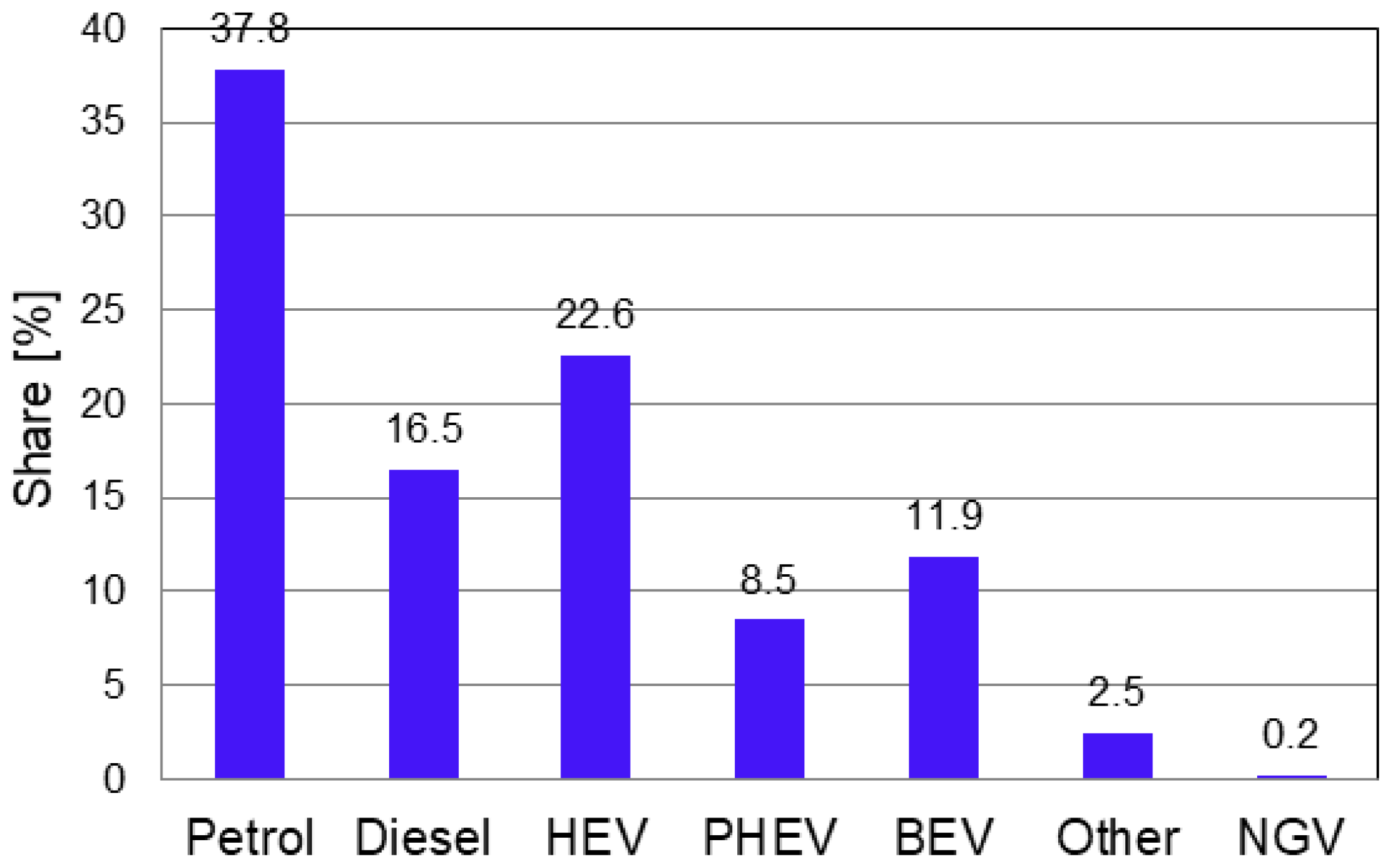

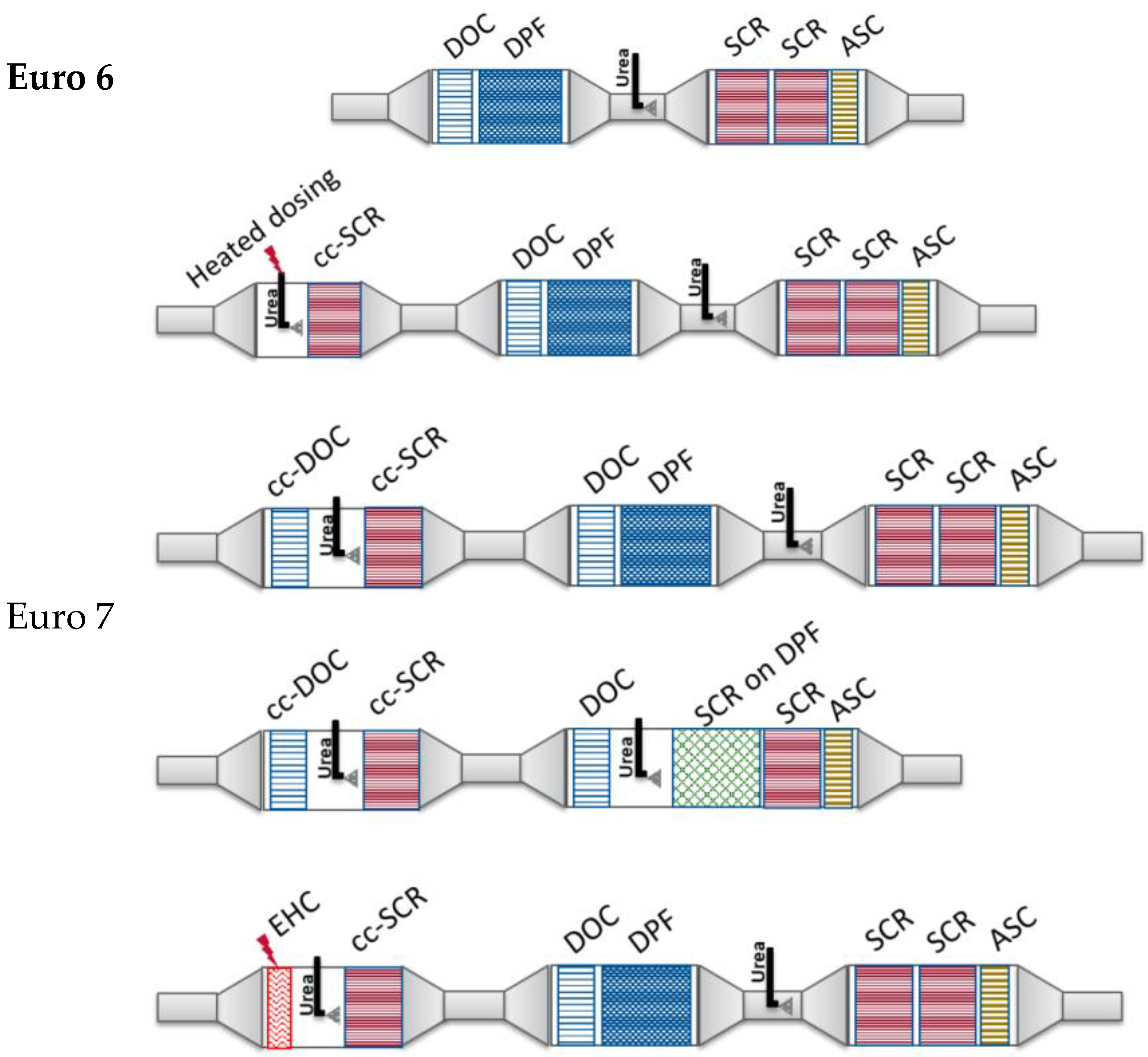


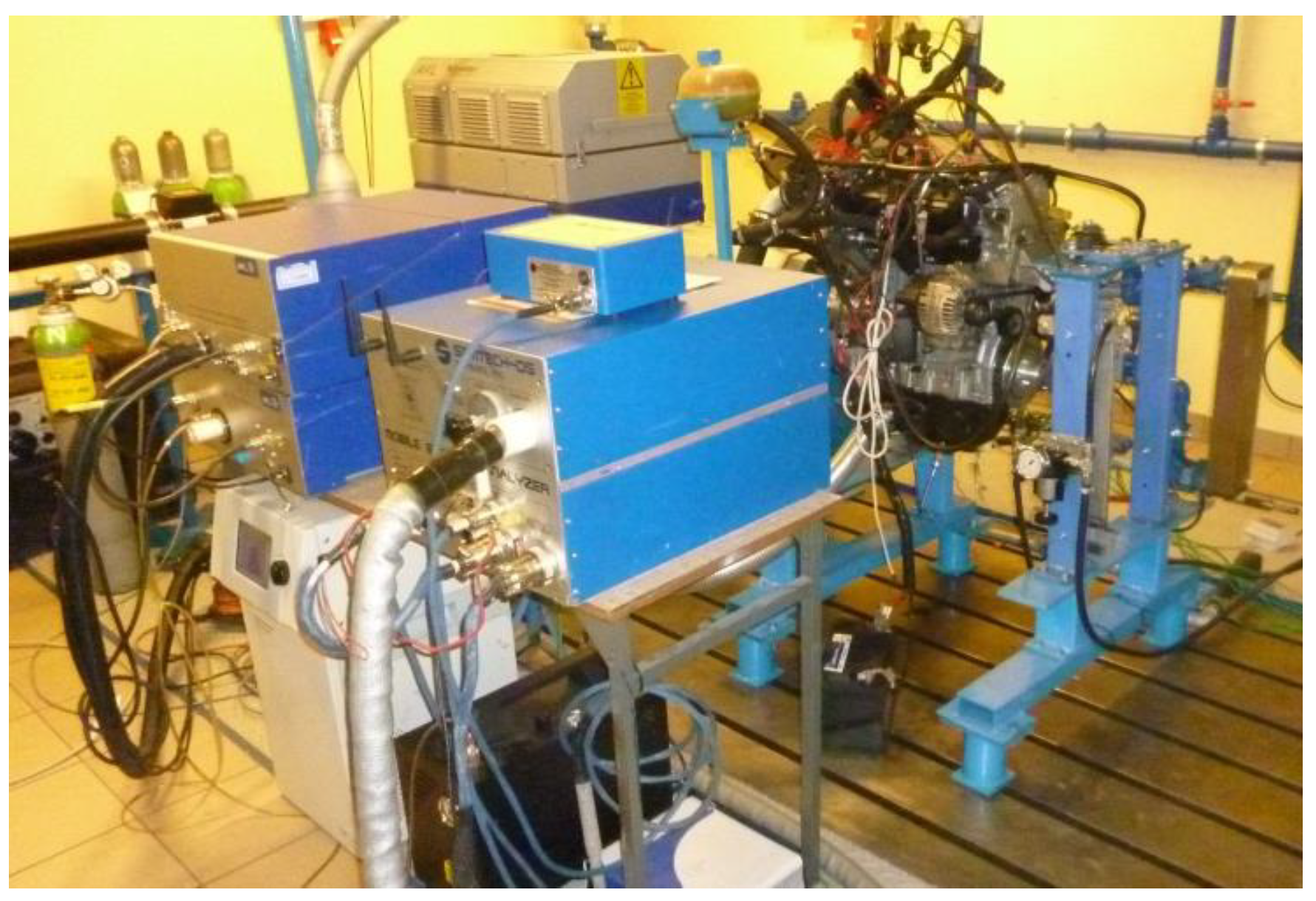



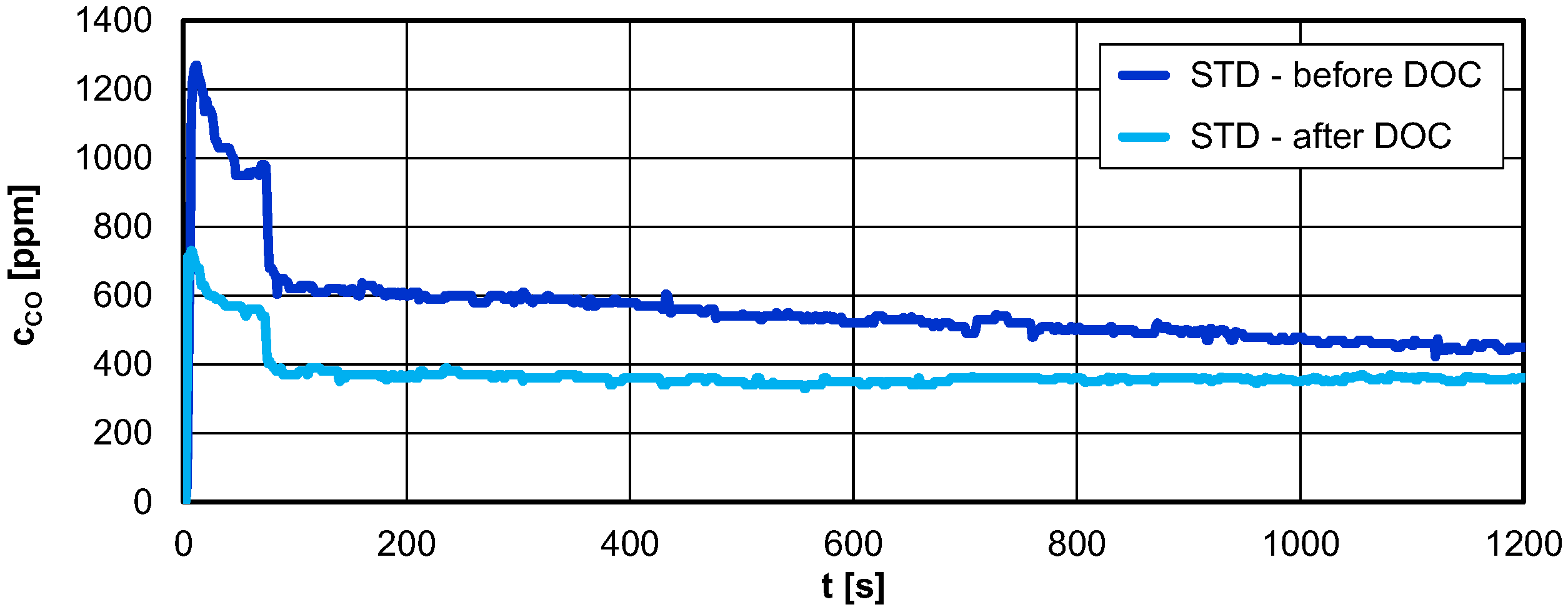
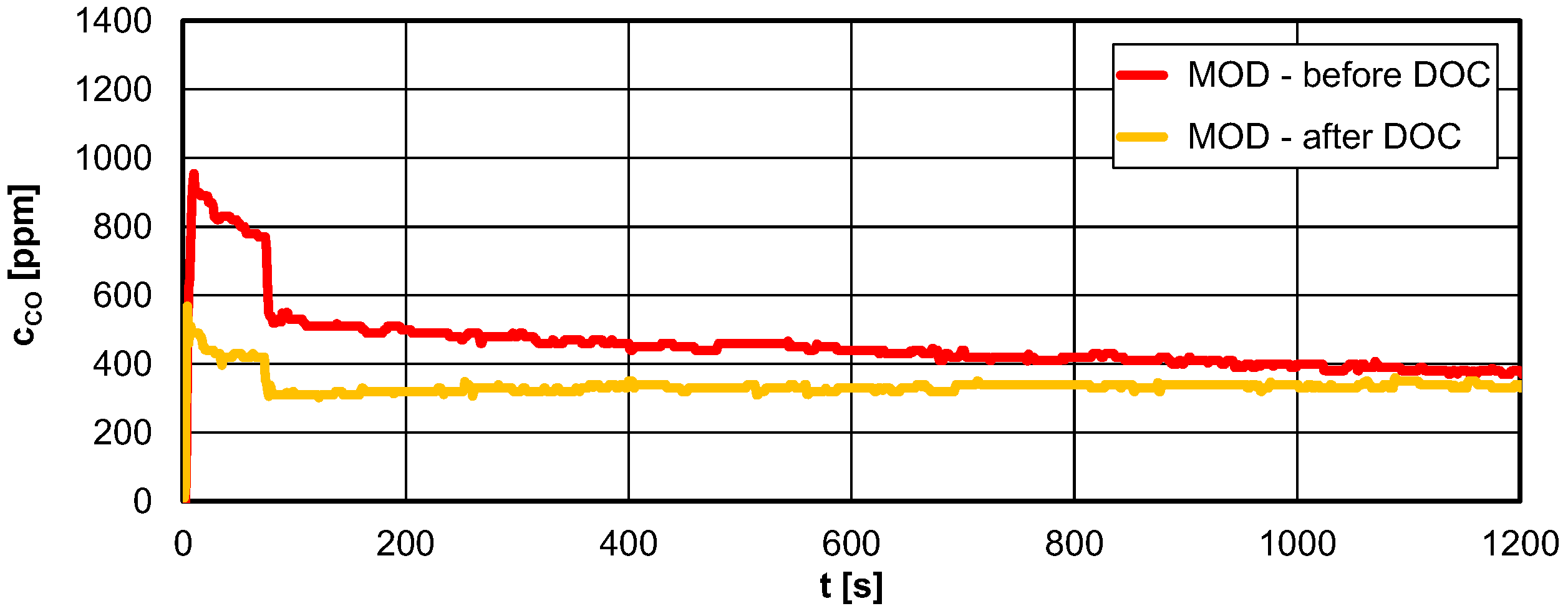
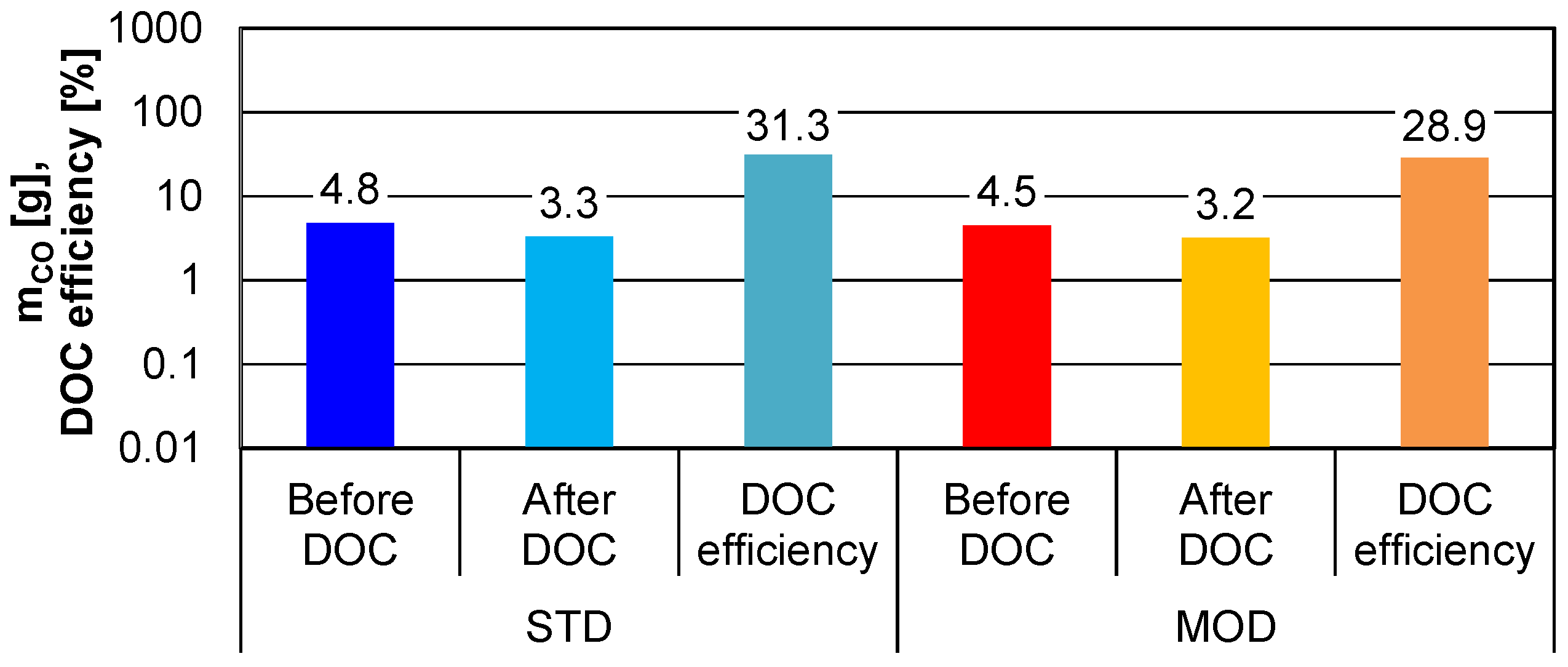
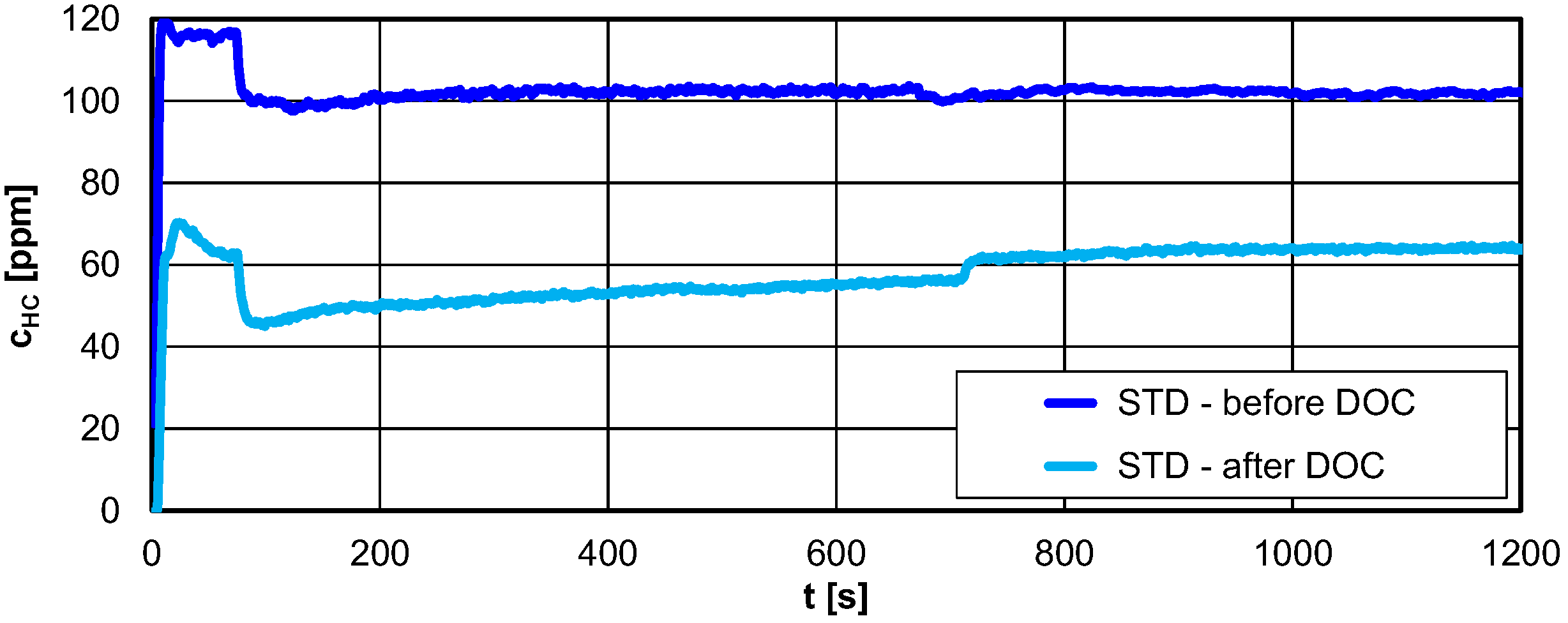
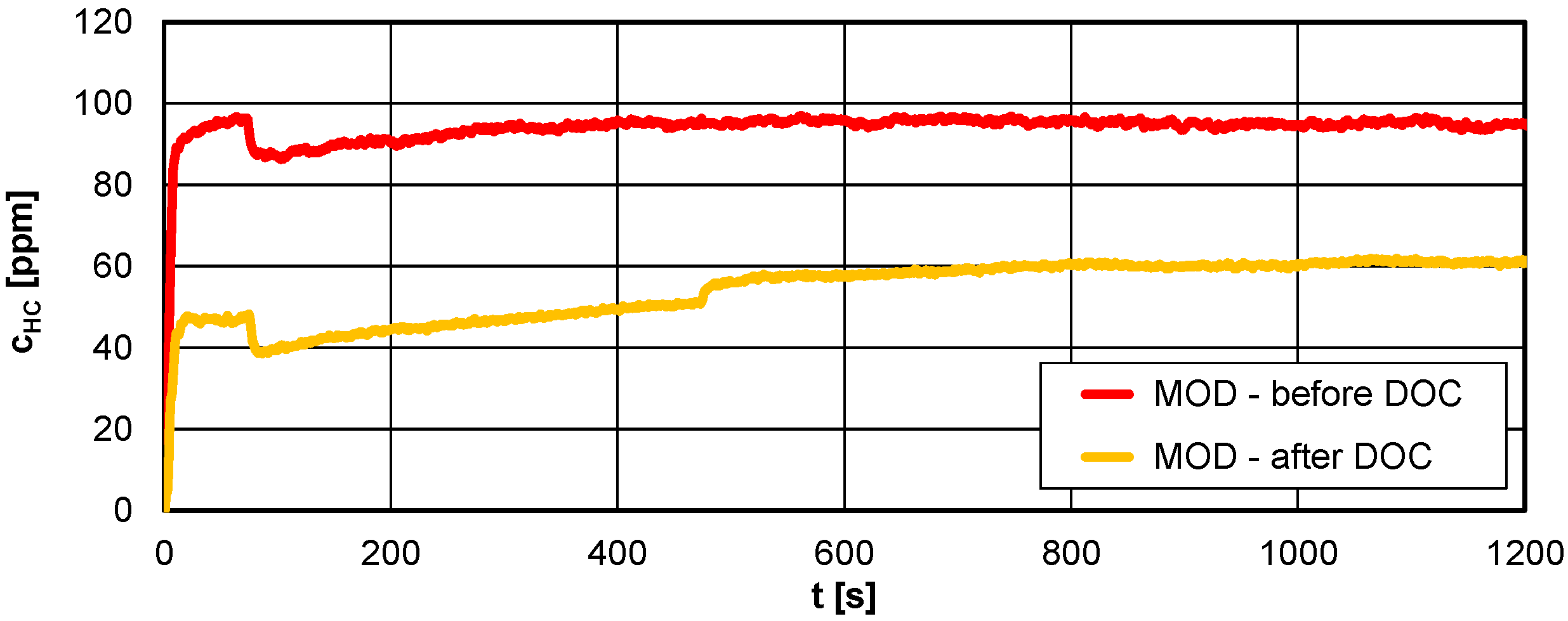
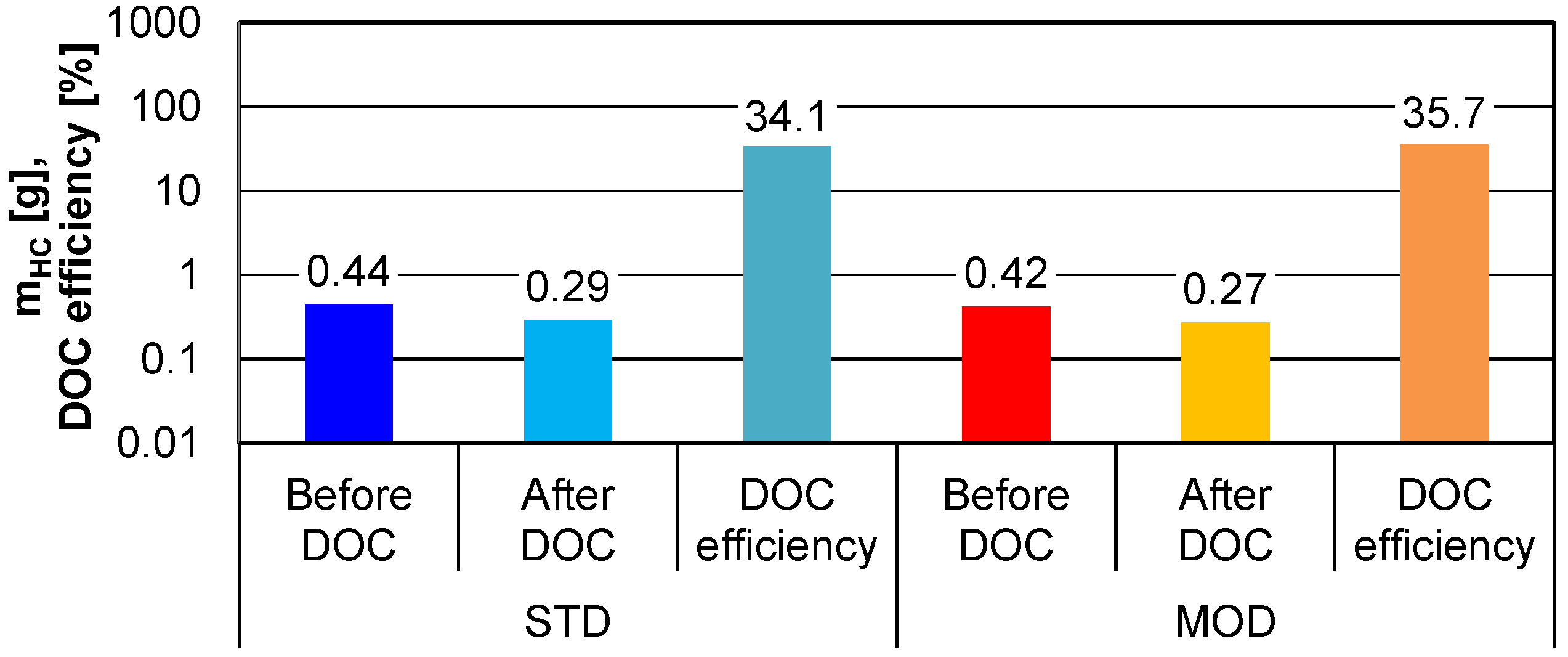
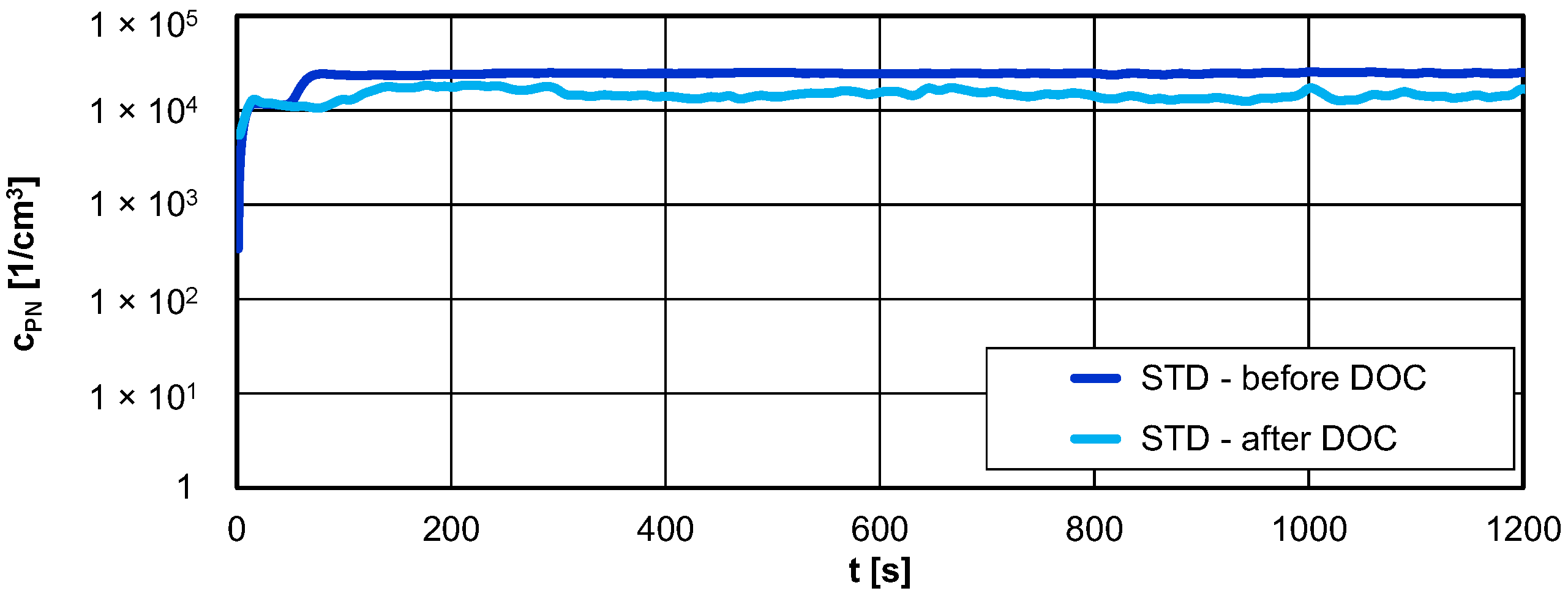
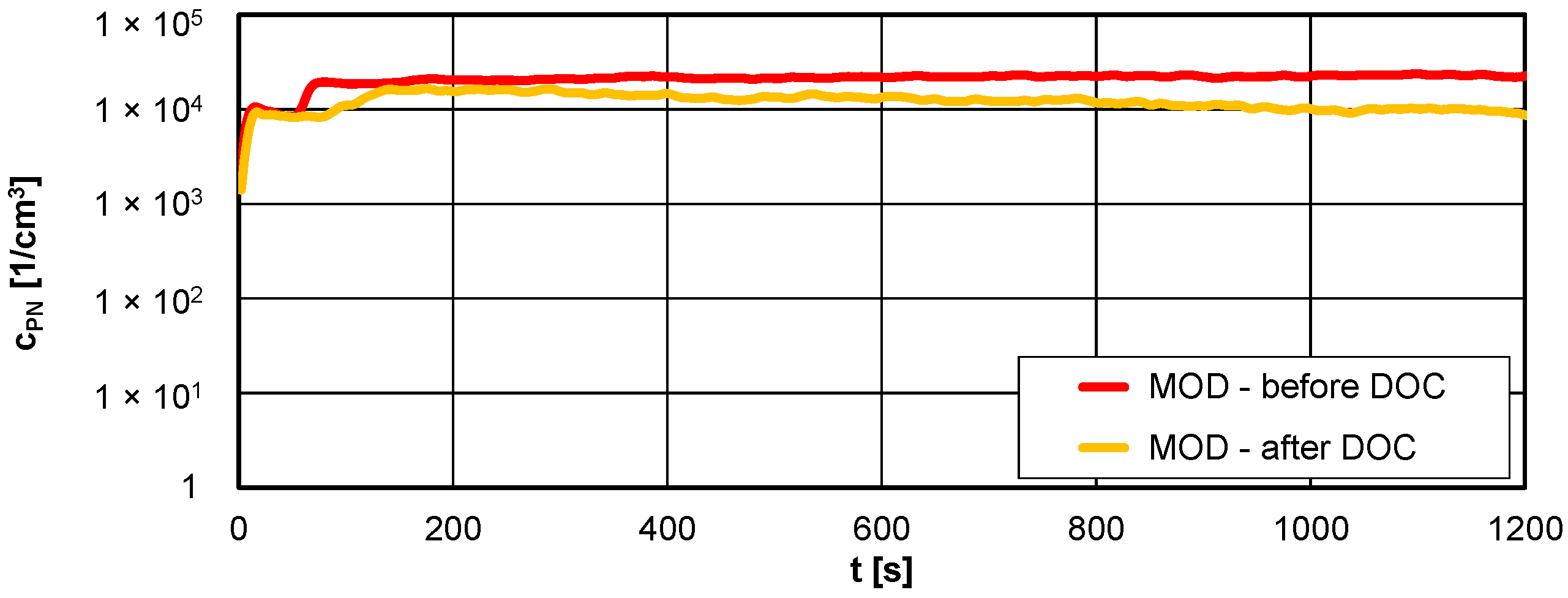
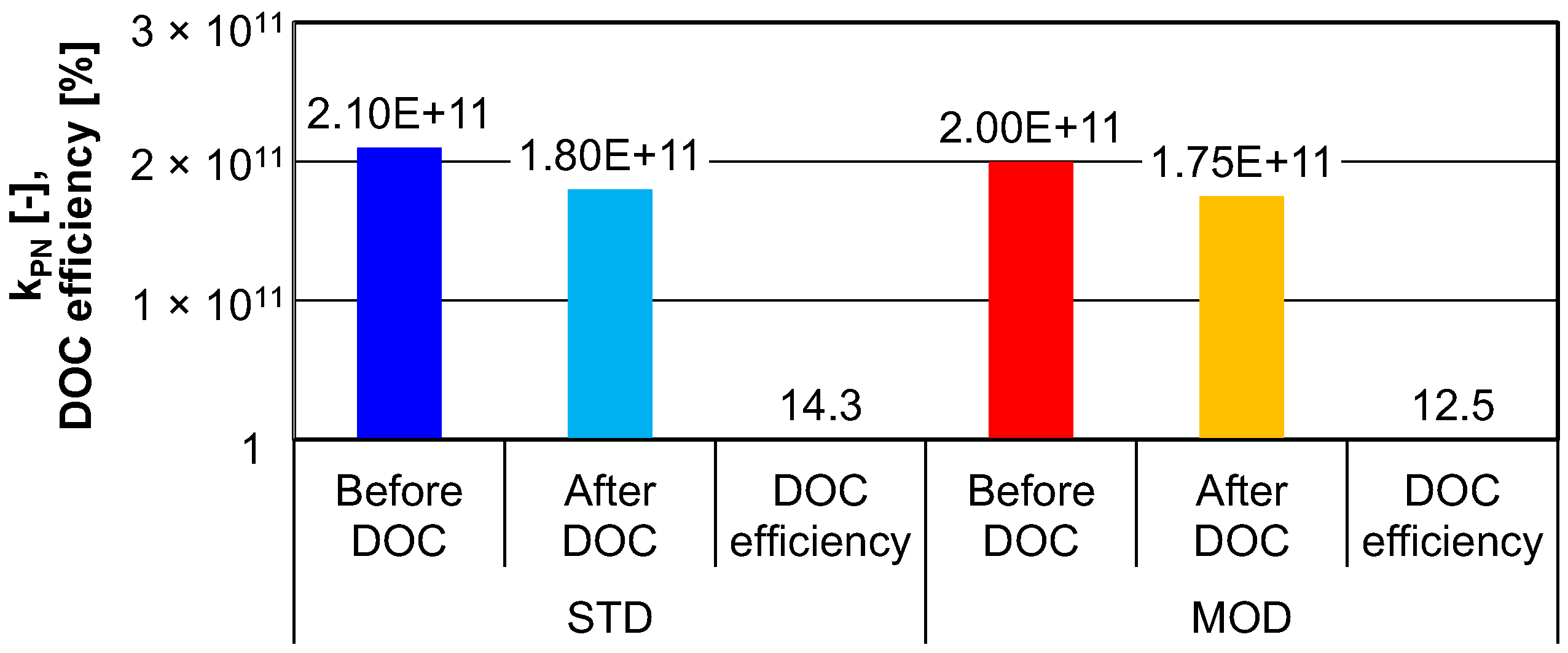
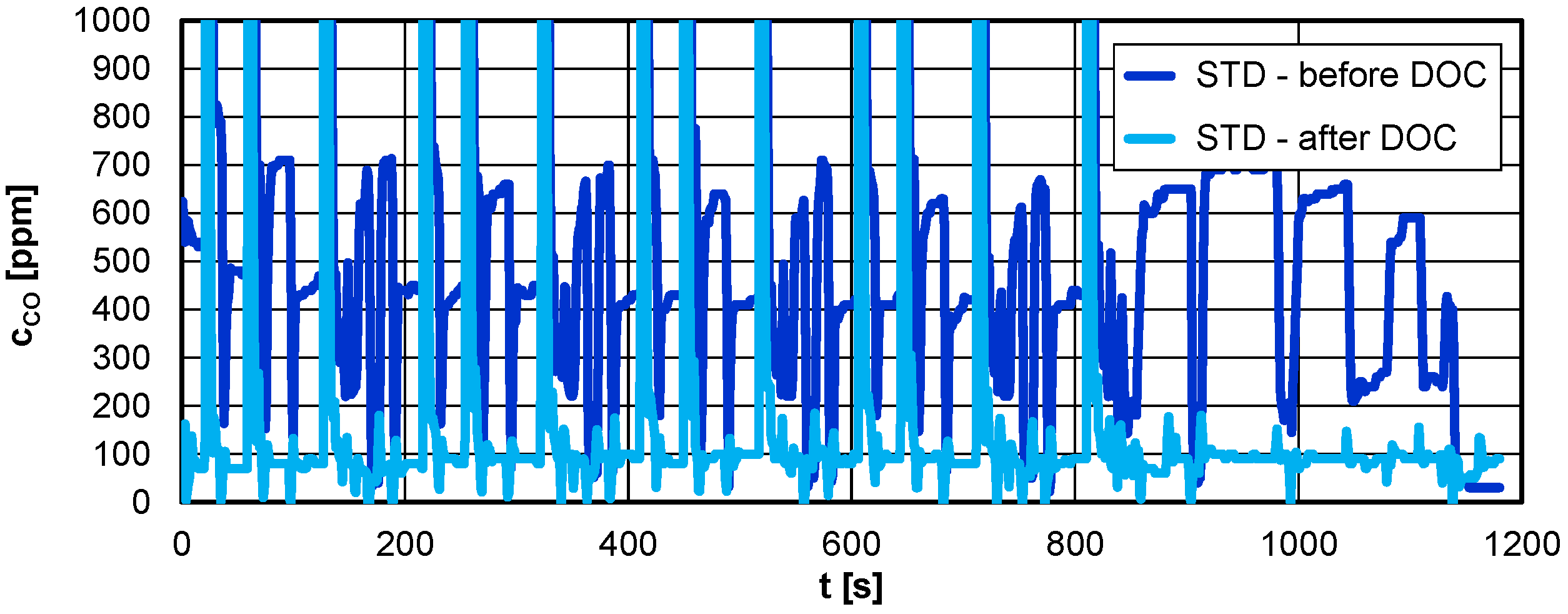
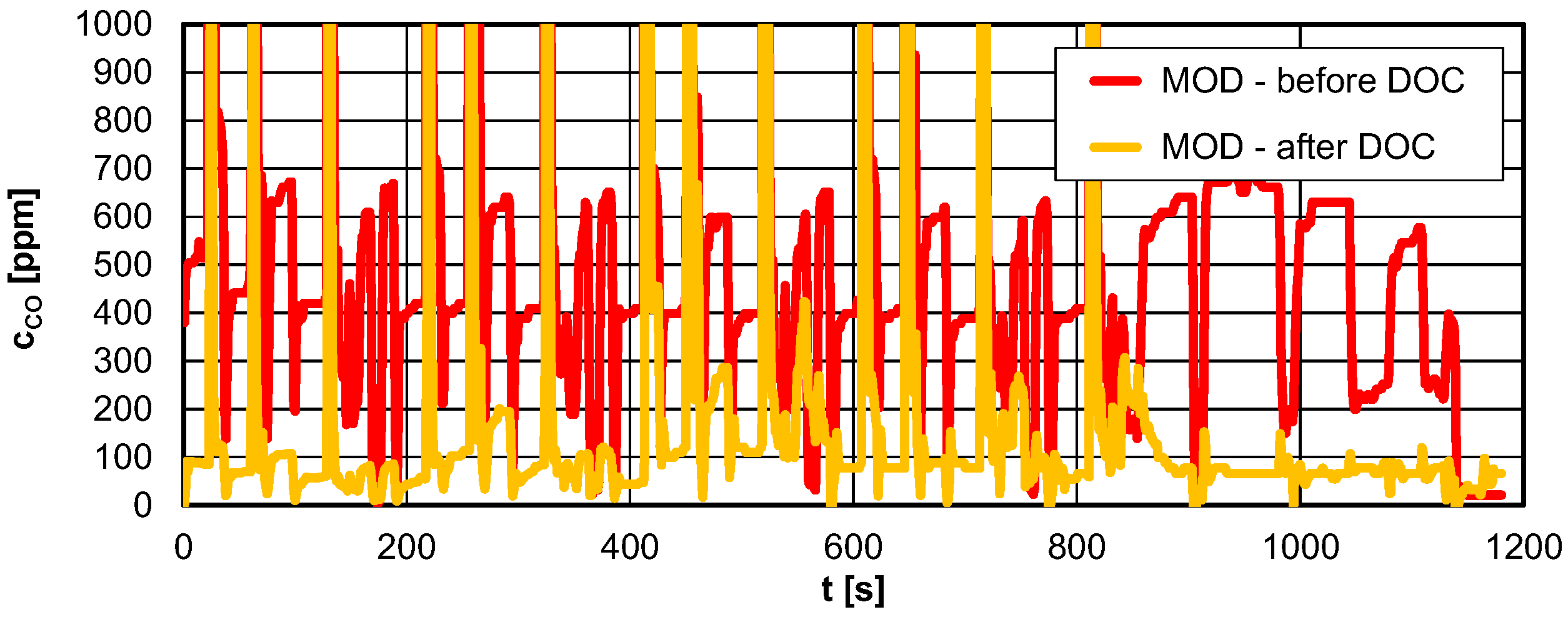
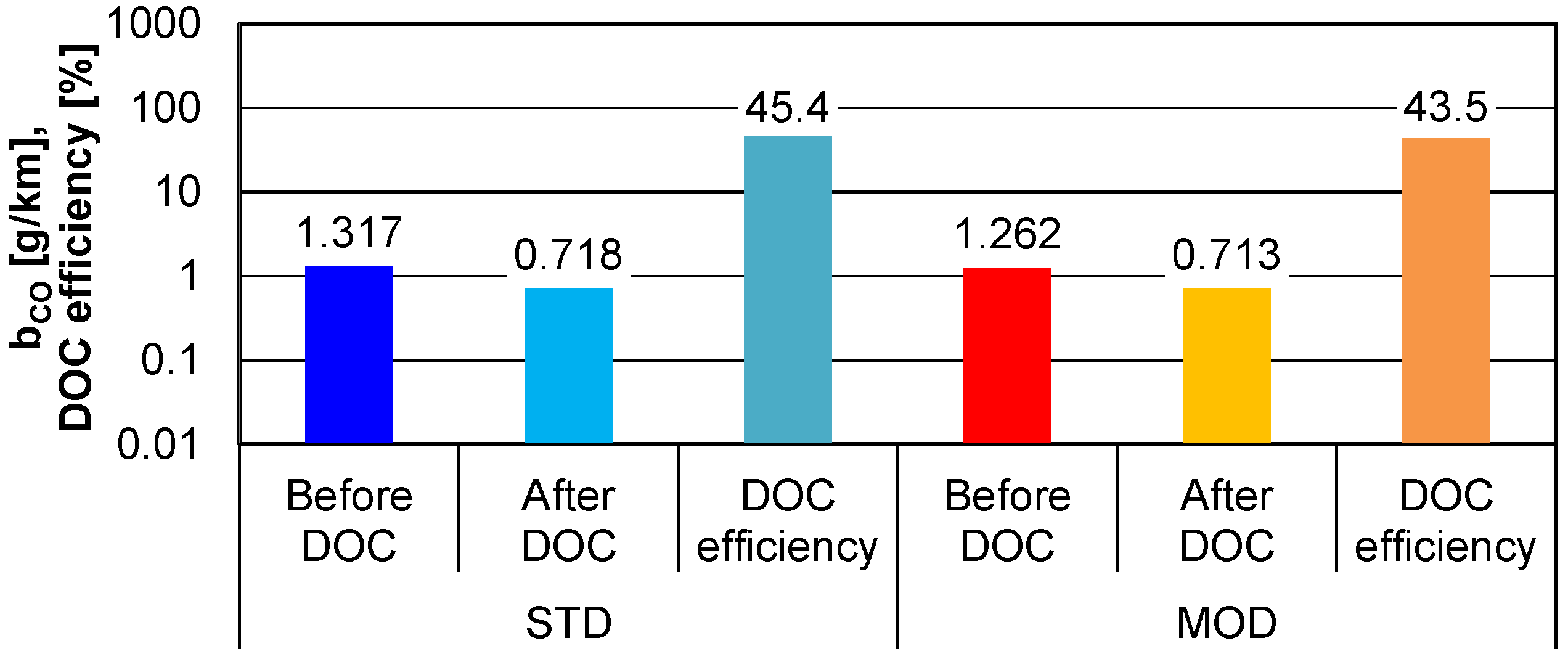
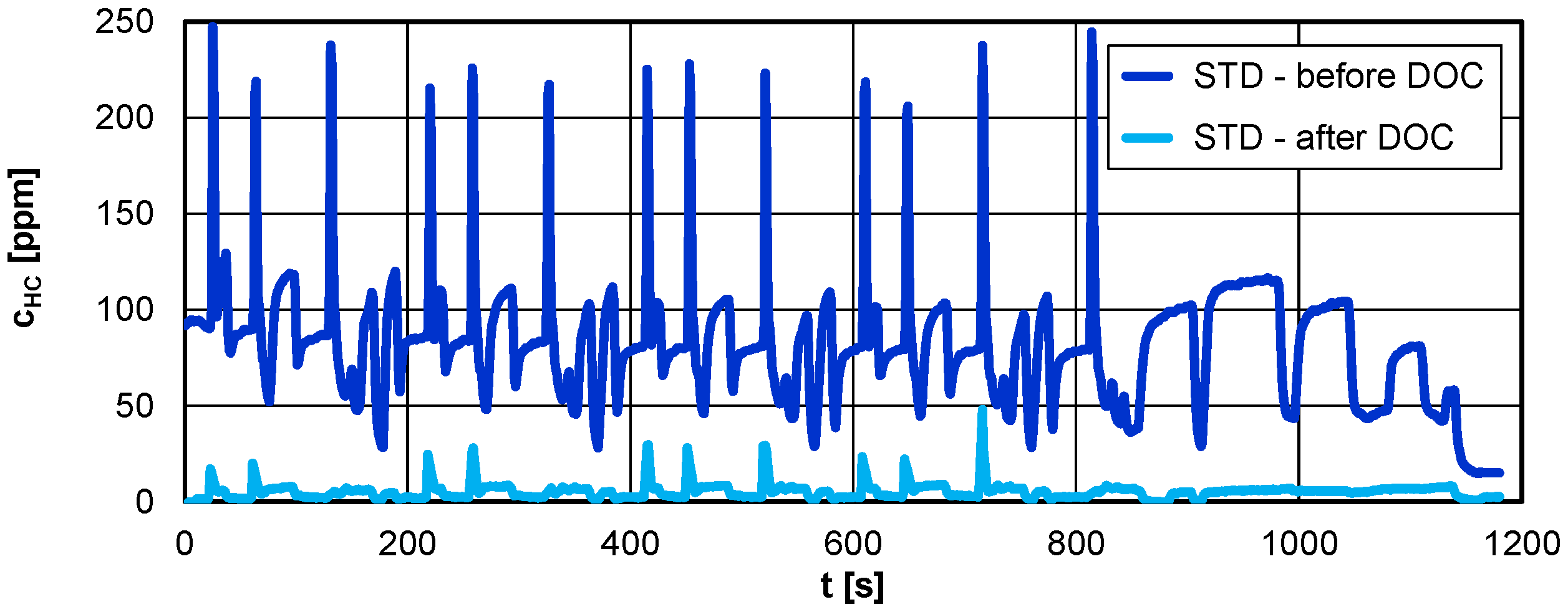
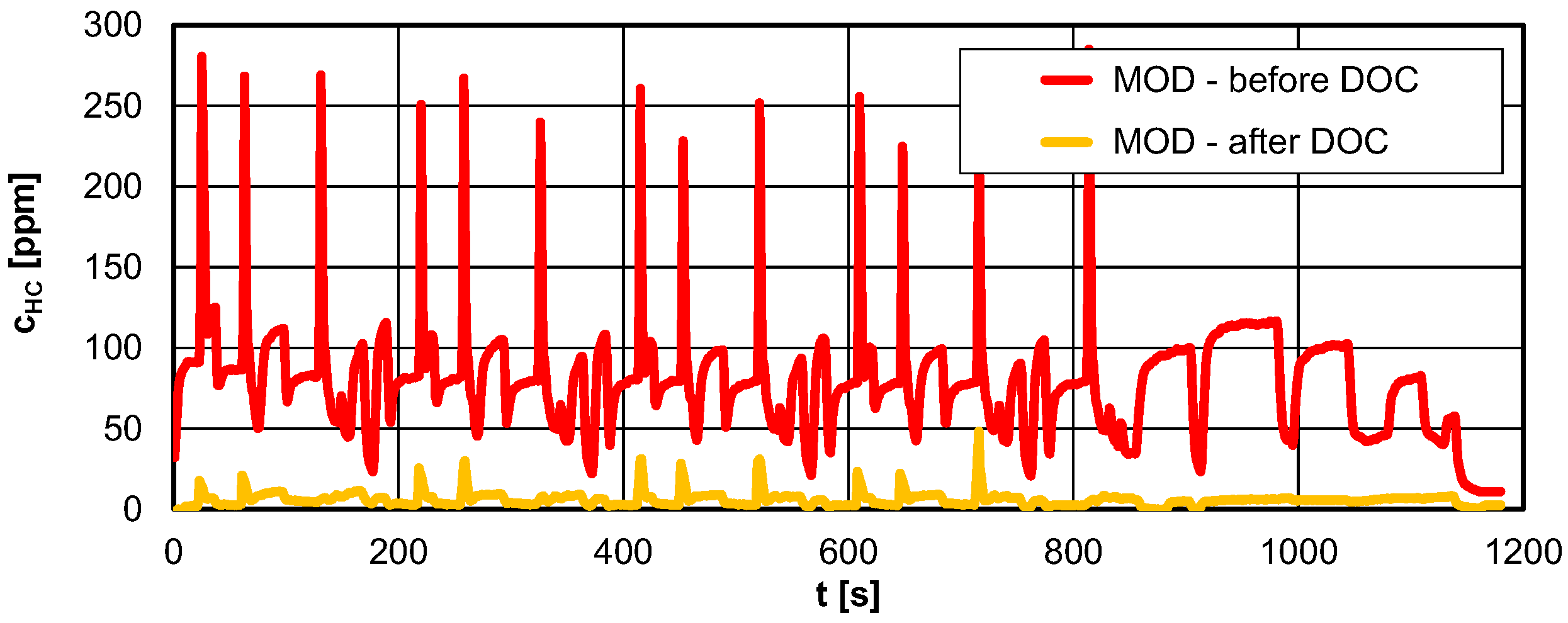
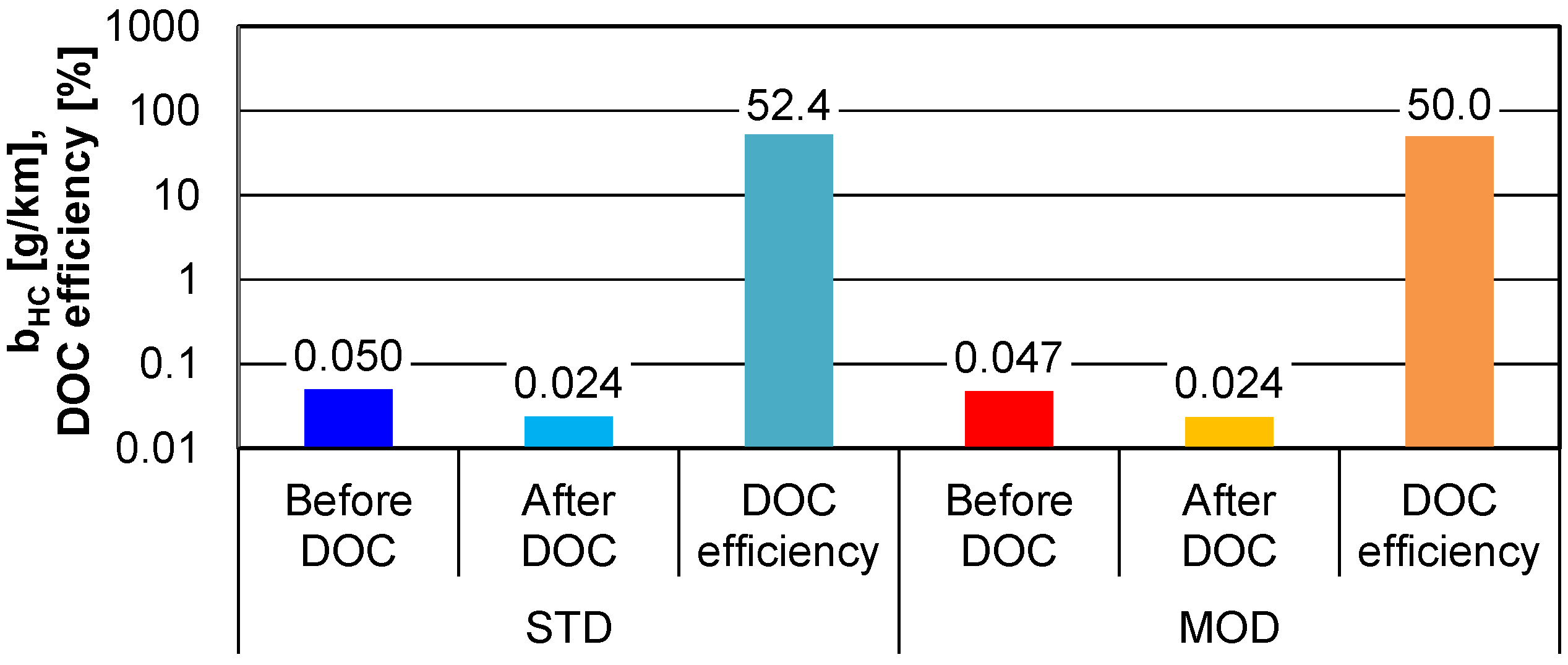
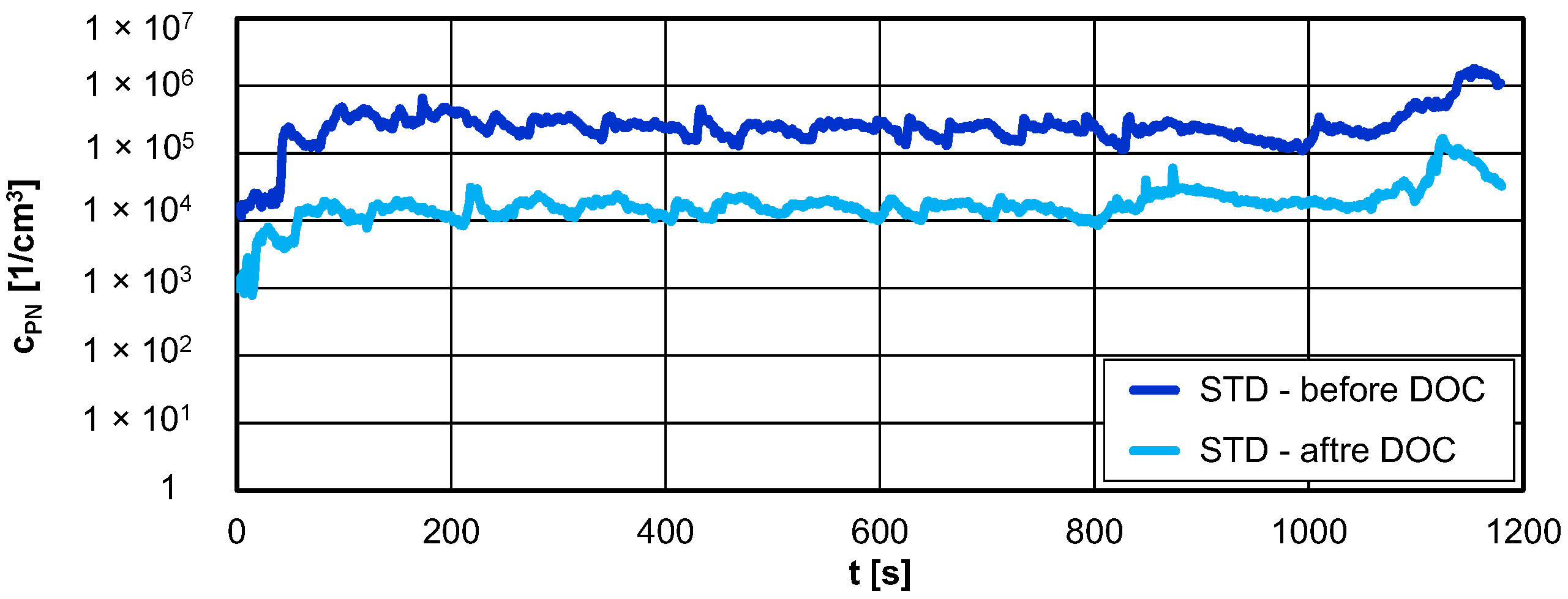

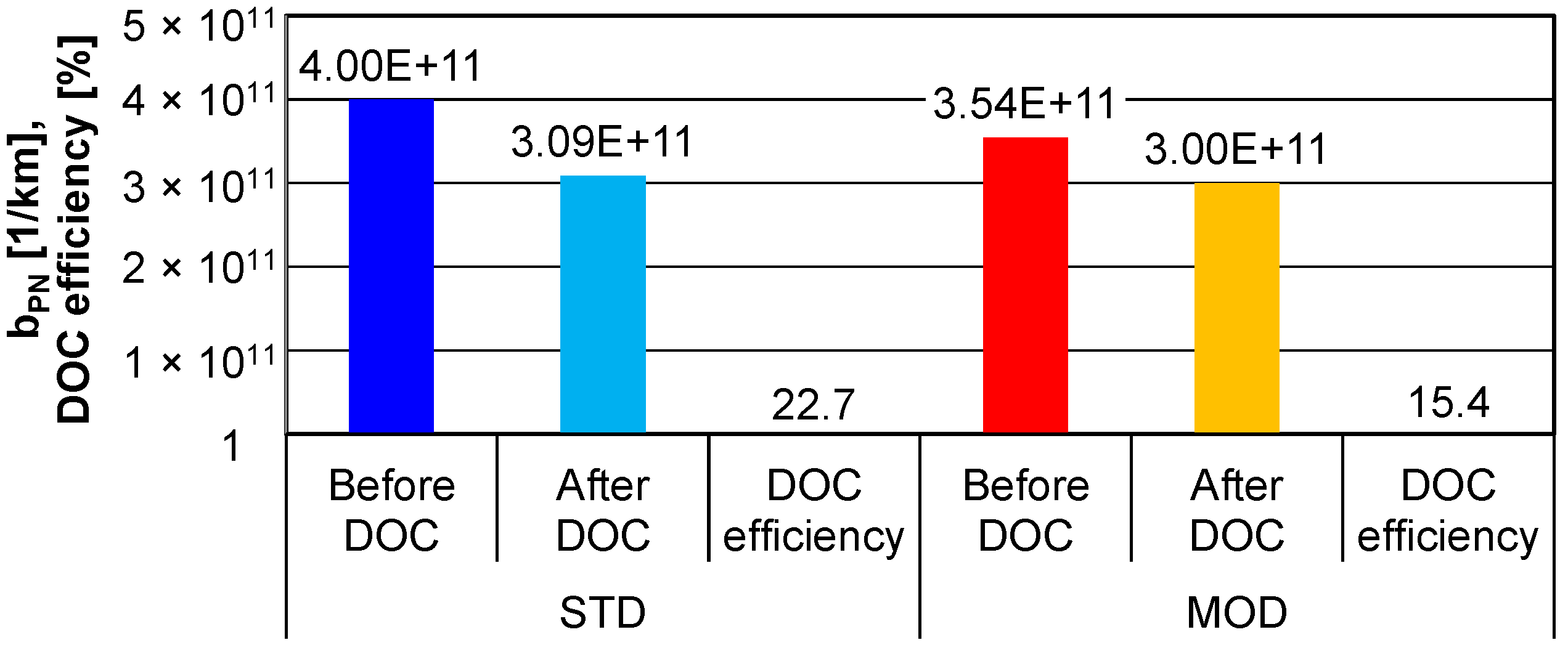
| Exhaust Emissions | Passenger Cars | Heavy-Duty Trucks | |||||
|---|---|---|---|---|---|---|---|
| Euro 6 (mg/km) | RDE CF | Euro 7 (mg/km) | RDE CF | Euro VII WHSC (mg/kWh) | Euro VII WHTC (mg/kWh) | PEMS CF | |
| PN (1/km) | 6 × 1011 | ≤1.5 | 6 × 1011 | ≤1.2 | 8 × 1011 | 6 × 1011 | ×1.63 |
| NOx | 60 | ≤1.2 | 30–40 | ≤1.2 | 200 | 230 | ×1.5 |
| CO | 1000 | 250–500 | ≤1.2 | 750 | 2000 | ×1.5 | |
| THC | 100 | 50 | ≤1.2 | 130 | 160 | ×1.5 | |
| NMHC | 68 | 35 | ≤1.2 | 65 | 80 | ×1.5 | |
| PM | 4.5 | 2.5 | 10 | 10 | |||
| NH3 | 10 | ≤1.2 | 10 ppm | 10 ppm | |||
| NO2 | 20 | ≤1.43 | 20 | ≤1.2 | 120 | 120 | |
| CH4 | 15 | 300 | 300 | ×1.5 | |||
| N2O | 10 | 10 | 10 | ||||
| CH2O | 2.5 | 5 | 5 | ||||
| HCHO | 5 | 10 | 10 | ||||
| Test Object Parameters | Value |
|---|---|
| Emission standard | Euro 4 |
| Fuel supply | Direct injection |
| Engine displacement | 1300 cm3 |
| Engine boost | Constant geometry turbocharger |
| Number of cylinders/valves | R4/8 |
| Injection system | Common rail |
| Max. injection pressure | 140 MPa |
| Number of injector holes/hole diameter | 5 holes/0.13 mm |
| Maximum power at rpm | 51 kW/4000 rpm |
| Maximum torque at rpm | 180 Nm/1750 rpm |
| Oxidation reactor | Yes |
| Particulate filter | No |
| Curb weight of the vehicle | 1250 kg |
| Parameter | Measurement Method | Accuracy |
|---|---|---|
| CO | NDIR, range 0–10% | ±3% of measurement range |
| HC | FID, range 0–10,000 ppm | ±2.5% of measurement range |
| NOx (NO and NO2) | NDUV, range 0–3000 ppm | 3% of measurement range |
| CO2 | NDIR, range 0–20% | 3% of measurement range |
| Exhaust gas flow | Mass flow rate | ±2.5% of measurement range |
| Engine diagnostics systems | ISO, CAN, VPW, PWM |
| Parameter | Value |
|---|---|
| Diameter range of measured particles | 5.6–560 nm |
| Number of measuring channels | 32 |
| Exhaust sample volumetric flow rate | 0.6 m3/h |
| Volumetric flow rate of compressed air | 2.4 m3/h |
Disclaimer/Publisher’s Note: The statements, opinions and data contained in all publications are solely those of the individual author(s) and contributor(s) and not of MDPI and/or the editor(s). MDPI and/or the editor(s) disclaim responsibility for any injury to people or property resulting from any ideas, methods, instructions or products referred to in the content. |
© 2023 by the authors. Licensee MDPI, Basel, Switzerland. This article is an open access article distributed under the terms and conditions of the Creative Commons Attribution (CC BY) license (https://creativecommons.org/licenses/by/4.0/).
Share and Cite
Andrych-Zalewska, M.; Chlopek, Z.; Pielecha, J.; Merkisz, J. Influence of the In-Cylinder Catalyst on the Aftertreatment Efficiency of a Diesel Engine. Energies 2023, 16, 2826. https://doi.org/10.3390/en16062826
Andrych-Zalewska M, Chlopek Z, Pielecha J, Merkisz J. Influence of the In-Cylinder Catalyst on the Aftertreatment Efficiency of a Diesel Engine. Energies. 2023; 16(6):2826. https://doi.org/10.3390/en16062826
Chicago/Turabian StyleAndrych-Zalewska, Monika, Zdzislaw Chlopek, Jacek Pielecha, and Jerzy Merkisz. 2023. "Influence of the In-Cylinder Catalyst on the Aftertreatment Efficiency of a Diesel Engine" Energies 16, no. 6: 2826. https://doi.org/10.3390/en16062826
APA StyleAndrych-Zalewska, M., Chlopek, Z., Pielecha, J., & Merkisz, J. (2023). Influence of the In-Cylinder Catalyst on the Aftertreatment Efficiency of a Diesel Engine. Energies, 16(6), 2826. https://doi.org/10.3390/en16062826







